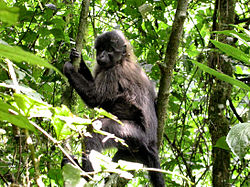| Uganda mangabey | |
|---|---|
 | |
| Juvenile | |
| Scientific classification | |
| Kingdom: | Animalia |
| Phylum: | Chordata |
| Class: | Mammalia |
| Order: | Primates |
| Suborder: | Haplorhini |
| Infraorder: | Simiiformes |
| Family: | Cercopithecidae |
| Genus: | Lophocebus |
| Species: | |
| Subspecies: | L. a. ugandae |
| Trinomial name | |
| Lophocebus albigena ugandae (Matschie, 1912) | |
The Uganda mangabey (Lophocebus albigena ugandae) [2] is a subspecies of the grey-cheeked mangabey (L. albigena), an Old World monkey, found only in Uganda and in the Minziro Forest Reserve, just over the border in Tanzania. Colin Groves upgraded the Ugandan population of this crested mangabey to the new species L. ugandae on 16 February 2007, but this is not widely accepted. This subspecies is significantly smaller than the other subspecies of grey-cheeked mangabey, with a shorter skull and smaller face. 2018 was the most recent year in which the International Union for Conservation of Nature assessed the conservation status of L. albigena ugandae, describing it as being of vulnerable. [1]

